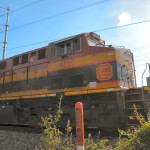The Train lines are pretty much the same as they were 110 years. There are 17 different railroads tracks which cross Houston neighborhoods on their way to the Sea. During that time our population has increased from 45,000 to over 2,100,000 people. Galveston is no longer an equal to Houston and our Port has grown tremendously. There are still 900 active rail crossings with lights and barriers impending traffic. Where millions of Houston Homeowners waste countless gallons of gas each year sitting in their cars praying the train will finally make it thru the crossing.
Projections for Rail in Houston
- Freight rail volumes will increase 55% by 2035
- For very 100 trucks on the road today, there will be 177 on the road in 2035.
- In 2035 52% of the jobs will be located inside Beltway 8, while 30% of the population live inside Beltway 8.
- There is very little right of way to add capacity to our existing freeway system.
- TxTag is helped move traffic quickly on our toll roads
- Upgrading will be needed to add commuter trains on existing rail.
- Funding issues for Commuter Rail may be solved by private enterprise.
Gulf Coast Rail District
The GRCD was started in 2005 and amended in 2009. Harris County, City of Houston, Fort Bend County, Waller County, Galveston County and the Port of Houston Authoirty all participate in the District. The group was formed to look at existing rail lines to see which can be used for commuter rail. To encourage freight rail growth while improving air quality, energy efficiency, and roadway congestion relief. Rail improvements are a win-win situation for goods and people.
A TxDot Houston Region Freight Study done in 2007 identified $3.4 billion of freight rail improvements which were needed. The public benefits would be better air quality, with less time wasted at crossings. Shippers are willing to pay $40 million a year, with the remainder of the money to come from public funds.
The public benefits would be:
- Consumer Products
- Roadway Mobility
- Roadway Safety
- Improve Community Livability
- Commute Alternatives
- Air Quality & Energy Efficiency
How to do it:
- Improve Rail Network Flow
- Shared Use
- Consolidated & Separate Corridors
COMMUTER RAIL
290 Commuter Rail Study Corridor ($348 million) – The rail along 290 is owned by Union Pacific. The rail goes from the 610 Loop to Hempstead. This is a northwest line not used for thru freight traffic. We could run passenger trains along this corridor when freight trains don’t run. The rail system would need to be extended from Loop 610 to downtown.
Galveston Commuter Rail Study Corridor ($840 million) – The rail is 50 miles in length and would end at the University of Texas Medical Center.
DFW – Intercity Rail – BMS Railways and Union Pacific both have tracks which could be sued. The Federal government has committed money for high speed rail. As regional airports reach capacity they are going to drop short commuter routes. If we sue the existing rail system we need some kind of connectivity, where the train end up at a transit center. High speed rail will need to be electrified. The existing corridor for trains can not be used for speeds over 150 miles per hour. A 200 mile per hour train will require separation and a new rail system. Opponents of the high speed rail system say the train will go 79 miles per hour. That is the speed most drivers now drive at on the freeway.
Where will the money come from?
- The GCRD has no taxing authority
- Federal Grants
- State Rail Relocation & Improvement Fund
- Fees
- Other??
Solutions will require regional support and Public-Private Partnership
Call Bill Edge at 713-240-2949 to see Houston homes in 24 hours or less
Source: Ms. Maureen Crocker, Executive Director, Gulf Coast Rail District

Leave a Reply